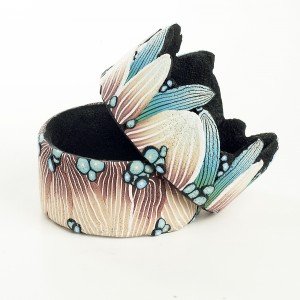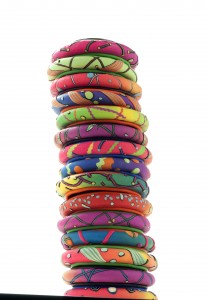Selling your production jewelry at a retail show seems to be a “no-brainer”—you have work you want to sell and that’s where there are a lot of customers. But not everyone is cut out for retailing and not every show is “your” show. There are some things you should consider.
First, do you enjoy talking to people about your work? Are you energized by selling directly to a wearer? If you’re terminally shy, selling to the public might not be for you. (Though if you just hate “selling” you can look at last week’s post on some tips to make it less painful.) If you really can’t bear to talk to people, but retail sales seem like the best outlet, consider online sales. (You will still have to communicate with people—and this time via writing, which is even worse for some people than talking.) There’s always the option of hiring friend—or trading for jewelry—to work the show for you. However, most buyers at an art show want to talk to the maker. Otherwise, they can go to a gallery.
Second, is this your show? Always visit the show you want to enter before you lay down your entry fee. Look around. Who are the attendees? What’s their demographic as far as age, lifestyle, earning potential goes? Does your work fit with the products being sold in terms of price, style, materials? What is the environment like in terms of lighting, space, parking, security? Do sales appear to be good or are there more lookers than buyers? Can you determine why?
Third, how far away is the show and how will you get yourself, your booth, and your work there? Airfare, shipping, hotels can quickly add to the cost of a show. John and Corliss Rose, of Two Roses in Anaheim, California, only attend local shows in order to keep costs down. If you must attend distant shows, for whatever reason, you may want to limit the number of such shows you do a year. Or, if you like the gypsy life, outfit an RV with a shop so you can travel and work on the road.
Fourth, what are the costs? What is the potential return in sales or in marketing information? Do these outweigh the financial costs as well as the time lost in the studio?
Fifth, do you need the feedback you can only get from real customers? Are you introducing a new line or design? Are you trying to break into a new market or a new demographic, are you using a new material? Going into a retail show and meeting customer face to face is often the only way you can find out if you’re on the right track. The Roses, who sell primarily wholesale, always participate in a few retails shows a year, just so they can get exactly this kind of invaluable information.
You may have to experiment a bit at the beginning—or any time you make a change in your product—in order to find out whether or not the “show fits.”


